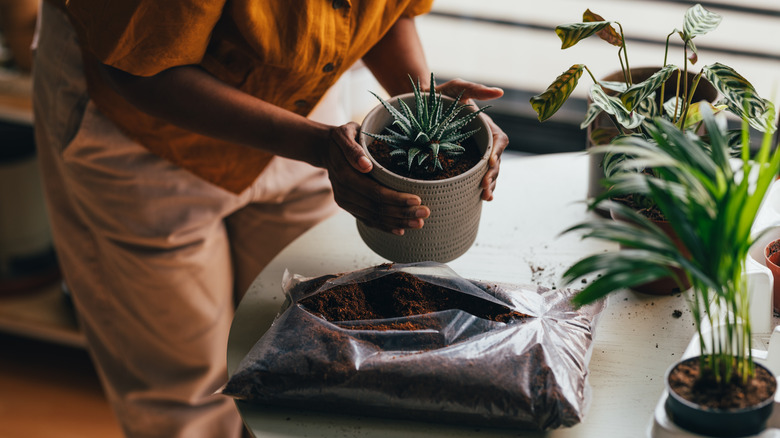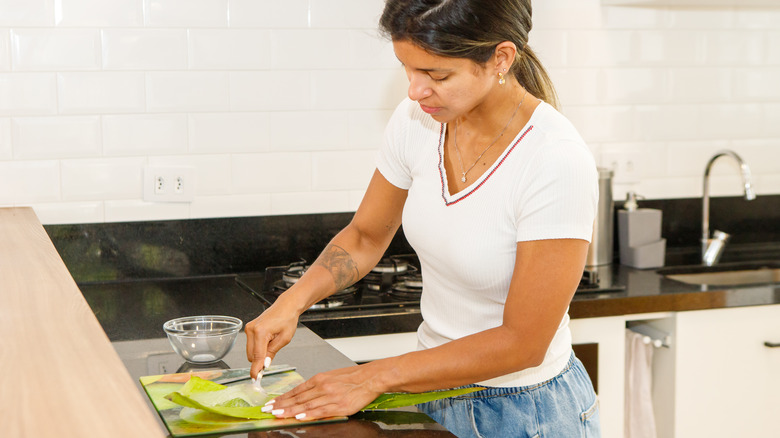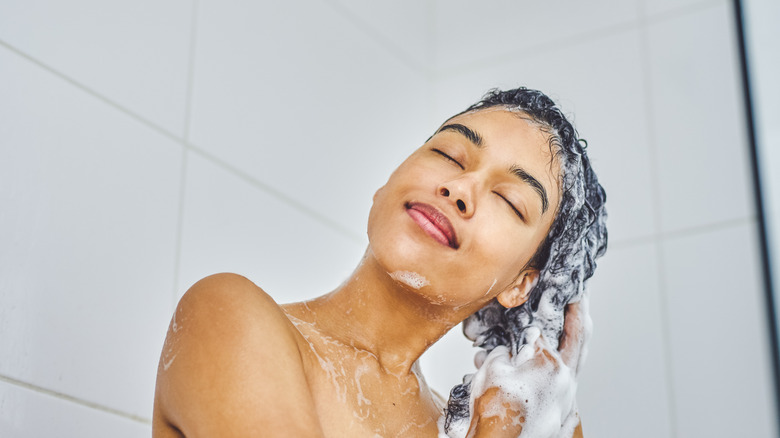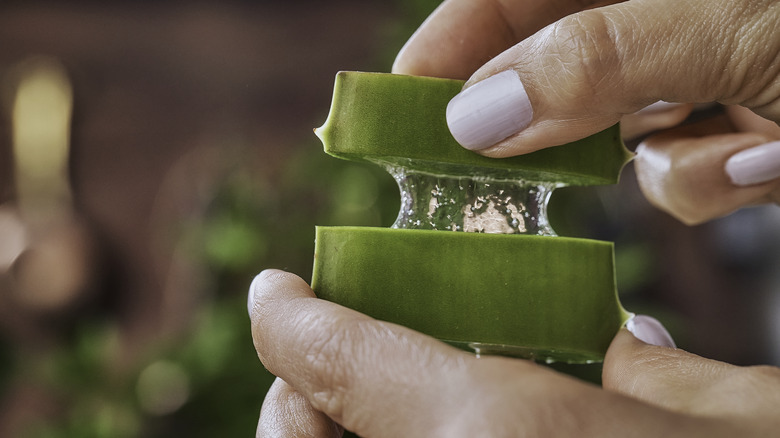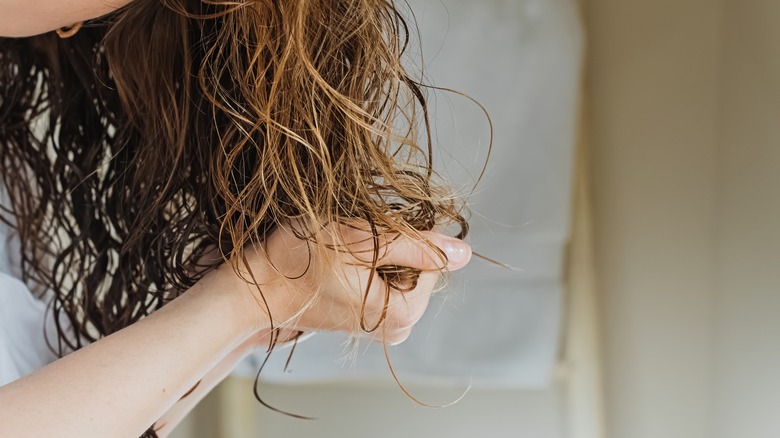Your Guide To Using Aloe Vera For Hydrated Hair & A Soothed Scalp
We're guessing you've probably heard of aloe vera. The plant has been around for thousands of years and contains a gel that's amazing at soothing irritated skin. Aloe vera gel is particularly useful in treating skin conditions like sunburn, while also serving as a super effective moisturizer. But did you know it also has multiple uses for our hair?
It's true. Aloe vera has been proven to have a number of benefits for the hair and scalp. Due to its anti-inflammatory properties, it can help calm an itchy scalp and treat issues like dandruff. But it's not just a dermatological aid; Aloe vera has also been proven to strengthen and repair the hair, particularly after it's suffered breakages or damage. That's because it contains vitamin A, vitamin C, and vitamin E, all of which can be lifesavers for our locks. But the benefits don't end there. It can also clean your hair (yes, it really is this multi-talented) as it's been proven to remove excess sebum. That makes for much healthier and shinier locks without the need for pricey shampoos and conditioners that can strip the hair in an unhealthy way. Another reason aloe is so good for the hair? Celebrity hairstylist Kerrie Urban told Real Simple it can actually help prevent UV damage to your locks! But there are a few things to know before slathering it on your head.
Aloe vera can be applied directly to the hair as a raw gel or mixture
Though aloe vera can come in different forms, for best results you'll want to use it in its raw gel form. One of the purest ways to get this is to purchase an aloe vera plant and literally retrieve it from the leaves yourself so you know for a fact it's totally natural and at its most potent. You can also buy the pure gel over the counter. This can then be rubbed directly into the scalp and hair as a weekly hair mask, bringing big benefits to both. "It's a great natural conditioner that can penetrate into the hair and scalp to hydrate strands and moisturize the scalp, helping to alleviate inflammation, itching, or irritation," celebrity hairstylist Sally Hershberger confirmed to Real Simple. It's recommended you leave the aloe mask on for around an hour, then wash it off using shampoo.
But if you can't get your hands on the raw mixture or prefer to apply it another way, aloe vera can be used in a quicker way to moisturize the hair by creating your own mixture. Combining one cup of water with half a cup of aloe vera juice can make a great everyday moisturizer. You can either apply this sparingly to the hair using your hands (focusing on the ends where hair tends to be drier) or spritz it on daily using a spray bottle.
But aloe vera can also be added to your existing hair products
There are plenty of shampoos and conditioners containing aloe vera that will bring the benefits of the gel to your scalp and hair. But if you're not keen on the idea of changing up your existing products, you're in luck. Cosmetic chemist, Tonya Lane explained to Byrdie that you can add either one or two tablespoons of aloe vera juice to your conditioner in order to make the most of its moisturizing qualities. This is particularly good for those looking to soothe their scalp, who have already found products that don't irritate their skin. But aloe isn't at its best with oil, so mixing it with hair oils won't get you very good results. "Due to the hydrophilic (water-attracting) makeup of aloe, it works well with other water-based ingredients like glycerin and water, rather than an oil," Lane shared.
It's worth remembering, too, that you'll likely reap the best results from aloe vera in its natural state, rather than mixed with something else. Especially if your hair products contain a lot of unnatural ingredients or things like sulfates — which might dry the hair out — working against aloe's moisturizing properties. "While it is not entirely clear, fresh aloe vera gel is likely more beneficial compared to products infused with aloe vera. Concentration in the fresh gel from the plant is much higher compared to infused hair care products," dermatologist Dr. Bradley Glodny explained to Prevention.
There are specific ways to keep your aloe vera at its most effective
If you're going for it and getting raw aloe vera from a plant or over the counter, it's important to store it properly in between uses to stop the gel from going rancid. It's natural after all, so it doesn't have a lot of the preservatives that can be added to products to prolong the time it takes for them to spoil. Though aloe vera gel has a number of miracle benefits, one thing it can't do is last forever once it's been harvested from the leaves.
To make your aloe last as long as possible, store it in the refrigerator in an airtight container. This will stop the gel from coming into contact with any bad bacteria (which you don't want all over your hair or scalp), and keeping it cold will ensure it stays fresher, longer. You can even keep any leftover aloe vera you've collected or bought in the freezer if you don't plan on using it more than once a week (or even less regularly than that if your hair doesn't need that much moisture. That way, you'll be giving your hair the best chance of reaping all the moisturizing and scalp-soothing benefits that your pure aloe has to offer.
Just make sure you're using aloe vera safely
As with anything new you're putting on your body, you'll want to make sure it suits your skin. It's never a bad idea to do a patch test before introducing something new into your routine — especially if you're applying it to a sore scalp — just to make sure you won't have any reactions to it. This involves applying a small amount to the skin and then leaving it on for a 24 period covered by a bandaid to see if a reaction occurs. Equally, though properly prepared aloe is safe for most people to eat in small doses, it can have a number of side effects when it's ingested in large doses or by someone with an intolerance, including leading to potential breathing difficulties.
Aloe can leave a film on the hair if it's not washed properly, making the hair look dull and limp. And it can actually end up working too well. Who'd have thought!? Tonya Lane told Byrdie that she found her hair actually became too moisturized after regular aloe application. To reverse the effects, she underwent a protein treatment to give her locks some life back. To avoid side effects like this, it's recommended you don't wash your hair with aloe more than once a day and only apply it as a separate moisturizer once a day. If you find this is too much for your locks, take that down to every other day or less until you find the right balance for you.
